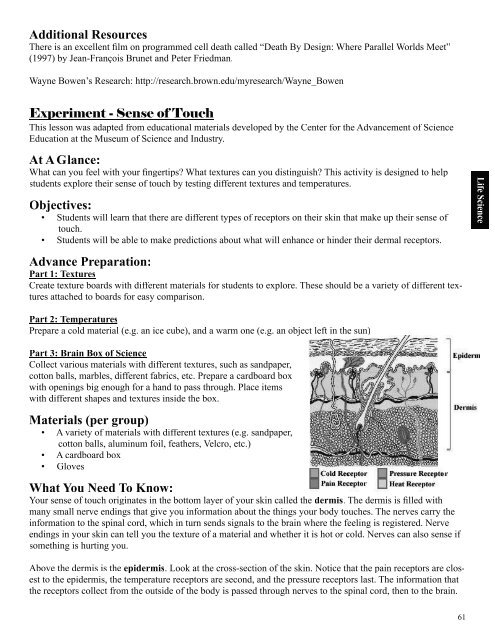ScienceMakers Toolkit Manual - The History Makers
ScienceMakers Toolkit Manual - The History Makers
ScienceMakers Toolkit Manual - The History Makers
Create successful ePaper yourself
Turn your PDF publications into a flip-book with our unique Google optimized e-Paper software.
Additional Resources<br />
<strong>The</strong>re is an excellent fi lm on programmed cell death called “Death By Design: Where Parallel Worlds Meet”<br />
(1997) by Jean-François Brunet and Peter Friedman.<br />
Wayne Bowen’s Research: http://research.brown.edu/myresearch/Wayne_Bowen<br />
Experiment - Sense of Touch<br />
This lesson was adapted from educational materials developed by the Center for the Advancement of Science<br />
Education at the Museum of Science and Industry.<br />
At A Glance:<br />
What can you feel with your fi ngertips? What textures can you distinguish? This activity is designed to help<br />
students explore their sense of touch by testing different textures and temperatures.<br />
Objectives:<br />
• Students will learn that there are different types of receptors on their skin that make up their sense of<br />
touch.<br />
• Students will be able to make predictions about what will enhance or hinder their dermal receptors.<br />
Advance Preparation:<br />
Part 1: Textures<br />
Create texture boards with different materials for students to explore. <strong>The</strong>se should be a variety of different textures<br />
attached to boards for easy comparison.<br />
Part 2: Temperatures<br />
Prepare a cold material (e.g. an ice cube), and a warm one (e.g. an object left in the sun)<br />
Part 3: Brain Box of Science<br />
Collect various materials with different textures, such as sandpaper,<br />
cotton balls, marbles, different fabrics, etc. Prepare a cardboard box<br />
with openings big enough for a hand to pass through. Place items<br />
with different shapes and textures inside the box.<br />
Materials (per group)<br />
• A variety of materials with different textures (e.g. sandpaper,<br />
cotton balls, aluminum foil, feathers, Velcro, etc.)<br />
• A cardboard box<br />
• Gloves<br />
What You Need To Know:<br />
Your sense of touch originates in the bottom layer of your skin called the dermis. <strong>The</strong> dermis is fi lled with<br />
many small nerve endings that give you information about the things your body touches. <strong>The</strong> nerves carry the<br />
information to the spinal cord, which in turn sends signals to the brain where the feeling is registered. Nerve<br />
endings in your skin can tell you the texture of a material and whether it is hot or cold. Nerves can also sense if<br />
something is hurting you.<br />
Above the dermis is the epidermis. Look at the cross-section of the skin. Notice that the pain receptors are closest<br />
to the epidermis, the temperature receptors are second, and the pressure receptors last. <strong>The</strong> information that<br />
the receptors collect from the outside of the body is passed through nerves to the spinal cord, then to the brain.<br />
61<br />
Life Science










